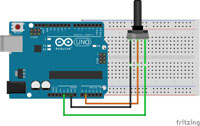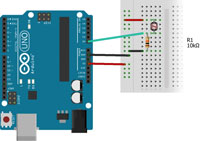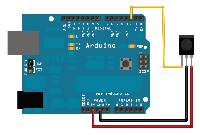Difference between revisions of "Janvi Mehta"
Janvi mehta (Talk | contribs) (→Sensors and Circuits) |
Janvi mehta (Talk | contribs) (→Sensors and Circuits) |
||
| Line 12: | Line 12: | ||
We learnt the use of bread board, where few connections are horizontal, few being vertical . With the help of it, I further added more LED’s, joining one of the connection with the ground and the other with the respective output pins and made it blink altogether. To this set up, we added the '''piezo buzzer''' , where one of the connection was to the ground and other to the respective pin (according to the coding). We managed to put the values in such a way, that the buzzer and the blinking work simultaneously. | We learnt the use of bread board, where few connections are horizontal, few being vertical . With the help of it, I further added more LED’s, joining one of the connection with the ground and the other with the respective output pins and made it blink altogether. To this set up, we added the '''piezo buzzer''' , where one of the connection was to the ground and other to the respective pin (according to the coding). We managed to put the values in such a way, that the buzzer and the blinking work simultaneously. | ||
| − | [[File:IMG-20170306-WA0009.jpg|thumb| | + | [[File:IMG-20170306-WA0009.jpg|thumb|100px]] |
Revision as of 23:22, 13 March 2017
Contents
Introduction
Hey, I am Janvi Mehta, second Year IAIDP (Information Arts and Information Design Practices) student. I am interested in branding, book layout, Illustrations and to keep learning new softwares. I like to explore, travel and know different things. I found interest in arduino and sensors since my first arduino class in foundation. This course started with a brief introduction of the projects, done in the previous course of Sensors,Probes and Detectors. The projects were too interesting, they had made some amazing things like a Turtle, Nano Satellite, Plant Interface and DIY Pollution sensor. After seeing these project ideas and when I came to know that this being the advanced version of the previous course, it increased my excitement level, to learn new things and to make interactive projects through hands-on workshop, building our own sensors.
Sensors and Circuits
I was introduced to the basics, starting with the circuit of LED (light emitting diode), where one of the connection is to the ground and the other onto, one of the output pin. With the help of the inbuilt codes, we made the LED blink, kept changing the delay values to make it blink faster or slower.
We learnt the use of bread board, where few connections are horizontal, few being vertical . With the help of it, I further added more LED’s, joining one of the connection with the ground and the other with the respective output pins and made it blink altogether. To this set up, we added the piezo buzzer , where one of the connection was to the ground and other to the respective pin (according to the coding). We managed to put the values in such a way, that the buzzer and the blinking work simultaneously.
The measuring instrument called a potentiometer is essentially a voltage divider used for measuring electric potential (voltage). Potentiometers are commonly used to control electrical devices such as volume controls on audio equipment. We connected the three wires of the Potentiometer to the aurduino board. The first goes to the ground from one of the outer pins, the second goes from the 5 volts, the third goes from any analog input to the middle pin. As I changed the frequency of the potentio meter, the LED’s blinked according to that pace and the analogValues were seen on the computer, the lowest being 0 and the highest being 1023.
LDR
IR
Reflection
Understanding the Basics
Reflection
It was a revision of what I had learnt in our school physics classes. We learnt the basic circuits and understood the terms Current (ampere), Resistance (R) , Voltage (Volt); The formula for Ohm’s law, being ( V= I*R) was taught through various examples. I completely understood the concepts especially after the examples. I further learnt the difference between the series and parallel connections.
Series Connection
In Series connection, the charge will pass through every light bulb. A series circuit can be constructed by connecting light bulbs in such a manner that there is a single pathway for charge flow. As more and more light bulbs are added, the brightness of each bulb gradually decreases. If one of three bulbs in a series circuit is unscrewed from its socket, then it is observed that the other bulbs immediately go out. In order for the devices in a series circuit to work, each device must work.
Parallel Connection
In parallel circuit, a single charge passing through the external circuit would only pass through one of the light bulbs. The light bulbs are placed within a separate branch line, which provides current through that particular branch. For parallel circuits, as the number of resistors increases, the overall current also increases. This increase in current is consistent with a decrease in overall resistance. If an individual bulb in a parallel branch is unscrewed from its socket, then there is still current in the overall circuit and current in the other branches.
Projects
A field trip to the Lake: Puttanahalli
The intention of our trip to the lake was to collect water samples and look for diatoms in it. For our trip we first made a list of things to take with us, like tape, toothbrush, gloves, clean water, tissues, labels, cloth, test tubes, dropper, containers , markers etc. We collected around 7-8 samples from different ares. Made a laddle with a stick and thread to find samples from the depth.
Reflection
It was a great and a different experience at the lake, we went around and collected water samples from seven to eight different sites. The water was filled with algae and greenery, there were birds chirping and there was plantation all around, the site was pleasing to me as it was peaceful. We collected water samples where ever we found different kinds of water, some being under the shade,leaf, rain water, water with waste, without waste, etc. It was a nice experience through out, I had never imagined myself coming to a lake and collecting water samples for analysing its components. I learnt how to plan things before going for a field trip, working as a team, it widen my thinking process seeing how other think and to implement those learning in future. I am looking forward to explore more and going for these kinds of expeditions.
Spinning Cup
The concept was to create a device to allow café and pastry chefs to do smaller decorations within cups and mugs or even to round off smaller cream domes. The simple mechanism involves a motor with a regulator that can be held easily to allow various orientations as well as speeds. The prototype involves:
- DC motor
- Diode
- Transistor
- Resistor
- Potentiometer
- Arduino
Reflection
The motor was connected to the holder which will be having the glass and as the frequency of the potentiometer is changed the pace of the motor also increases and decreases forming a pattern inside the glass. We made the outer appearance of the project, finding appropriate boxes, glasses, to hide the arduino, wires, potentio meter, bread board, to make it look more appealing.
ECG Sensor
We were then given Sensors to explore like the Pulse Sensor, Vibration Sensor, Heart Pulse, ECG Sensor, Motion Sensor, LDR sensor, IR Sensor, Carbon Dioxide and Sound sensor.
- Arduino
- Jumper wires
- ECG Electrode Connector
- ECG Electrodes - 3 pieces
Reflection
Electrocardiography is used to help diagnose various heart condition. I was admitted few weeks back into the hospital and this is something which I used to think everyday. How great are these technologies, it looked like some rocket science until I made it myself. I had never imagined me making an ECG Sensor ever. I never thought it would be so easy, it looked quite scary to me initially. I was really glad, I could do the connections completely on my own. I had placed the heart pads on both the arms. The cables were coded and had proper placement.
Turbidity Meter
The turbidity sensor detects water quality by measuring the levels of turbidity. It uses light to detect suspended particles in water by measuring the light transmittance and scattering rate. We had tried it with 6 solutions made with water and milk. We had put it in a box to keep it dark and then provided light from one side. It worked perfectly, the variations in the reading were relatable to the solution we kept in the glass.
- LDR Sensor
- Resistor
- Arduino
- Jumper wires
- Glasses
- Light source (torch)
Relfection
I learnt how the turbidity is sensed and if I want to do that with drinking water or lake water it would be a great experiment to do and analysing it. I enjoyed the entire process, had few difficulties deciding the outer appearance and tried various things.
Beyond Electronics
We (human and non-human) all sense our environments, without the mediation of electronic instruments. What if our sensors, probes, and detectors are alive?
We set out to explore on a more conceptually expanded scale, what it means to sense, probe, and detect our environments and the inhabitants within.
We were shown various projects done under biodesign using arduino, where they combined nature and art. I was very astonished to see how it works, they had made sensors to detect plants or parts of the skin. Showed us a jugaad sensor, water Quality site done by ArtScience Bangalore team, which shows the percentage of fluoride, nitrate, Ph in the water. Everyone brainstormed and wrote a list of sensors which are alive like hair on our body that stands due to friction, touch me not plants, plankton, electric eal, genetical evolution, vibro, photo bacterium, algae, glow in the dark worms,etc. We then observed the water samples in the microscope and saw how in such a tiny drop of water were the micro organisms living and moving.



